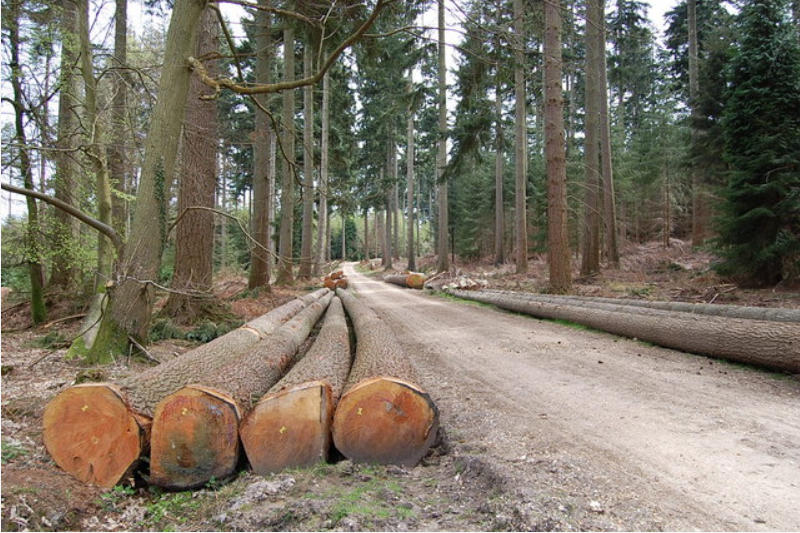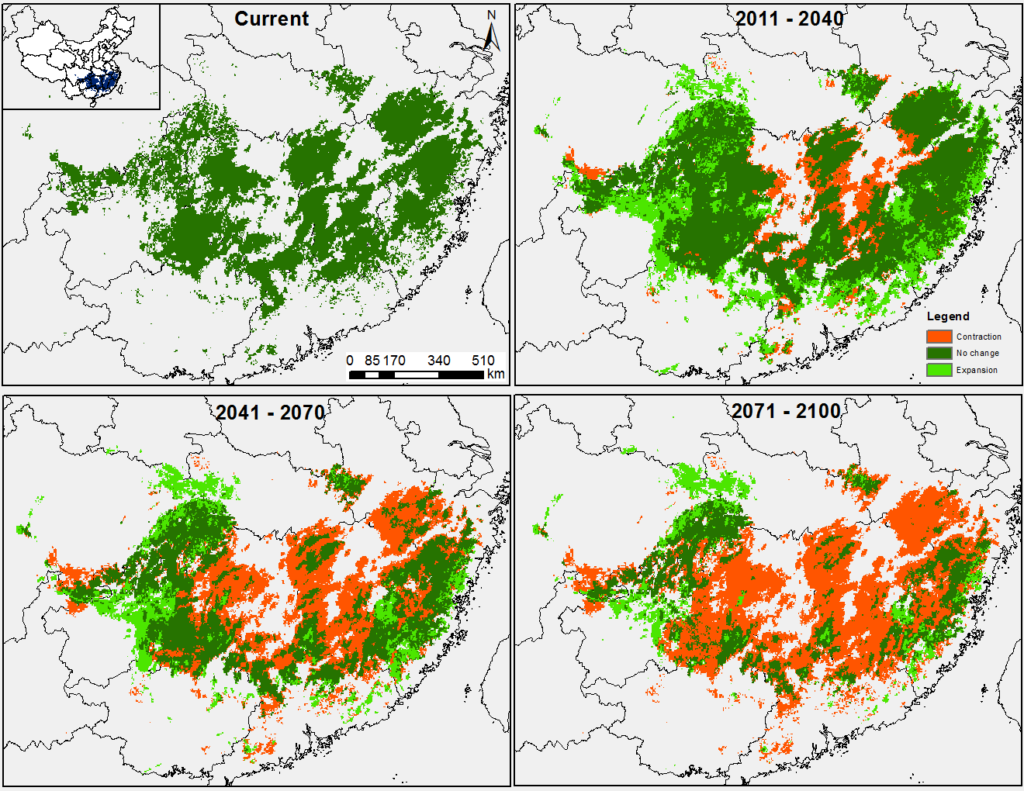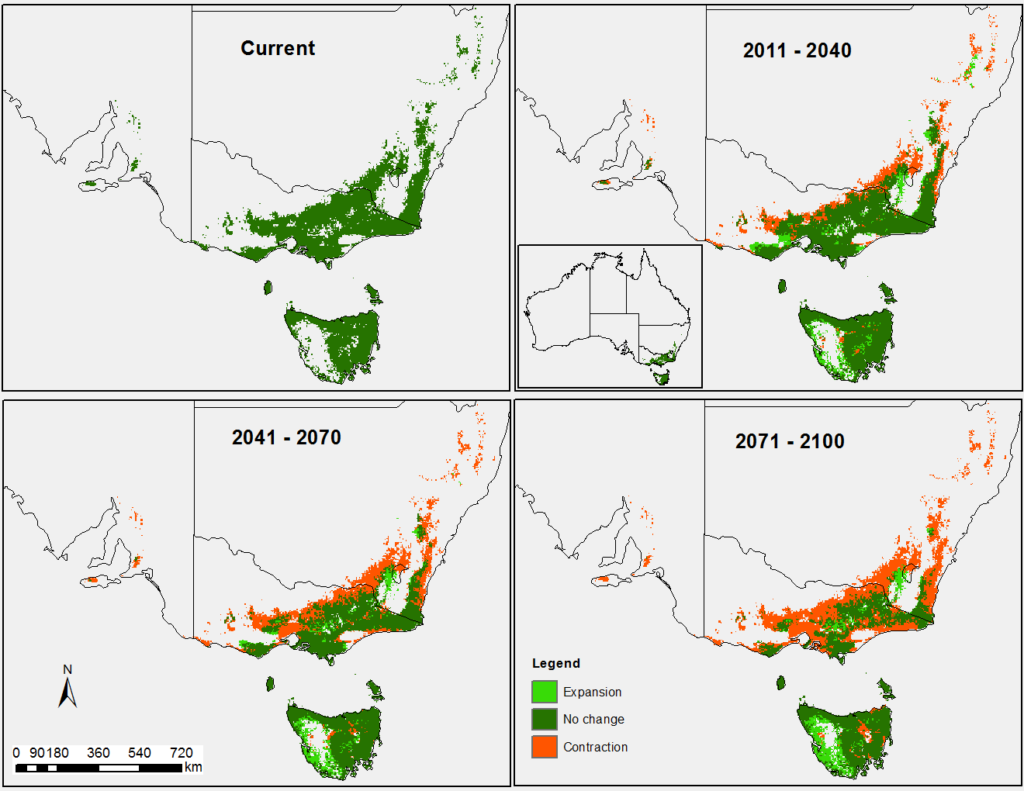9 Topic 5.2. Case Studies with Forest Tree Species
Contents
1 Douglas-fir
1.1 Climatic niche and future projections
1.2 Impact of climate change
1.3 Management strategies
2 Chinese fir
2.1 Climate niche and climate change impact
2.2 Limiting factors
2.3 Management strategies
3 Bluegum
1 Douglas-fir
Douglas-fir (Pseudotsuga menziesii) is a major coniferous species in western North America. It is one of the most fast-growing forest tree species with high wood quality in western North America. It also has a relatively low pest infection.

Figure 1. Douglas-fir trees in Vancouver, BC. Image by Korszun is licensed under CC BY 2.0
1.1 Climatic niche and future projections
Figure 1 shows its realized climatic niche for the current and three future periods. For the current period, predictions were made from 10 Random Forest models and integrated according to the consensus among the 10 model’s predictions.
The ranges of the climate niche for Douglas-fir are -0.6 ~ 16.0°C for mean annual temperature, -13.8 ~ 10.8°C for mean coldest month temperature, and 260 ~ 6040 mm for mean annual precipitation. The climate niche is not likely to change although its geographical distribution will change in future climates.

Figure 2. Geographic distributions of climate niche for Douglas-fir based on multi-model predictions for the current (1961-1990). Image by Tongli Wang under CC BY 4.0.
1.2 Impact of climate change
Figure 3 shows the consensus projections for the three future periods 2020s, 2050s, and 2080s. For each of the future periods, each of the 10 models was used to project the futures with 15 GCMs for a moderate climate change scenario RCP4.5, and the final projections were based on the consensus among the 150 (10 x 15) projected layers. The climatic niche is projected to expand northward at the leading edge (Figure 1) and upwards (not easily visible). However, contractions are not apparent at the trailing edge, which is special as most species in this region are projected to shift northward.
Overall, projected changes are 1.4 degrees of increase in latitude and 89 m in elevation of the distribution. The total area of suitable climate for this species will increase by about 10%.

Figure 3. Geographic distributions of climate niche of Douglas-fir for the three future periods 2020s, 2050s, and 2080s using consensus projections based on the climate change scenario RCP4.5. Image by Tongli Wang under CC BY 4.0.
1.3 Management strategies
As Douglas-fir is a favorable forest tree species, it is desirable to plant this species as much as where its suitable climate conditions become available. Thus, assisted migration of this species through plantation can be an effective way to take the advantage of a warming climate in British Columbia. The climate-based seed transfer system (CBST) recently launched in this province would facilitate the management of genetic resources.
2. Chinese fir
This species is prized for its durable wood and cultural and ornamental value. It is the species of choice for building temples, furniture, houses, flooring, and boats. Chinese fir trees occupy 30% of all plantations in China and account for 25% of national commercial timber production. Thus, Chinese fir is one of the most socially and economically important coniferous species in China.

Figure 3. Chinese fir forest and logs. Image by Clive Perrin is licensed under CC BY-SA 2.0.
2.1 Climate niche and climate change impact
The climate niche of Chinese fir spans 9.2 ~ 22.6°C in mean annual temperature and 830 ~ 3060 mm in mean annual precipitation. It is geographically distributed in southern China (Figure 4). Climate change is projected to have a drastic impact on this species.
Future projections of its climate niche suggest that the geographic distribution for Chinese fir may substantially contract under predicted climate change (Figure 4). The contraction in its current distribution, particularly in the south, was not a surprise as warmer climate conditions are projected to occur in the southern parts of its current distribution. What was a surprise was the lack of a predicted northward expansion for this widespread species as projected for most species in the north atmosphere, such as Douglas-fir. As a result, the climate niche distribution of Chinese fir is expected to decrease by 34% by 2050 and more than 50% at the end of this century.

Figure 4. Geographic distributions of climate niche of Chinese fir for the current and three future periods 2020s, 2050s, and 2080s using consensus projections. Image by Tongli Wang under CC BY 4.0.
2.2 Limiting factors
The limited northward expansion is likely attributable to the spatial pattern of precipitation in China. Current species distribution and its predicted current climatic niche occur in areas with mean annual precipitation (MAP) above 830 mm. Under future climates, the geographic distribution of temperatures suitable for this species is projected to move northward; however, the geographic distribution of mean annual precipitation is projected to remain about the same as for the reference period (Figure 5). The areas with MAP above 830 mm are mostly south of the Yangzi River. The sharp contrast in precipitation between northern and southern China appears to play an important role in the direction of future projections and may limit the northward expansion of this species.

Figure 5. Spatial patterns of mean annual temperature (MAT) and mean annual precipitation (MAP) for the current and the 2050s. Image by Tongli Wang under CC BY 4.0.
2.3 Management strategies
It is worth noting however that the climatic niche modeled in this study (or in the vast majority of other studies) is a realized climatic niche. It reflects the climate conditions currently occupied by the species. Whether or not Chinese fir can grow outside of the current climatic niche is unknown and needs to be further explored through field experiments, such as provenance tests.
The dramatic decline in the area suitable for Chinese fir projected in this study is concerning as this species is one of the most important forest species in China in term of both its economic value and role in ecosystem functioning. Our results should provide an early warning for policymakers and practitioners to develop adaptive strategies in species selection and forest management practices in order to adapt the management of Chinese fir forests/plantations to future climate. Managing this species within its current geographical distribution will become increasingly problematic as its current climatic niche becomes fragmented which may lead to a loss in the economic value of plantations and impair forest ecosystem functioning.
Genetic conservation should be a high priority for this species. In situ conservations should be established through parks and reserved areas in areas projected to be climatically suitable for this species in the future. For areas projected not to be suitable for this species, ex situ conversation should be planned, including seed storage, clone banks, and assisted migration.
3. Bluegum
Bluegum (Eucalyptus globulus Labill.) is a major plantation tree species in Australia. Another reason for including this species as a case study here is that it is distributed in the southern atmosphere. Therefore, the shift in the climatic niche of this species is southward instead of northward.
The geographic distribution of the climatic niche for blue gum is projected to shift southward towards cooler conditions. The poleward shift will be constrained by the Tasman Sea at the leading edge and thus result in a contraction of its total distribution under future climates (by 24% in the 2050s) (Figure 6).
The contraction in the overall climatic niche of blue gum on the mainland of southeast Australia could have negative implications for the productivity and vitality of blue gum plantations into the future but positive outcomes for plantation and forest managers in Tasmania. However, the adaptive capacity of eucalypt plantations is considered high with many eucalypts grown on short rotations (<10 years). This provides managers with opportunities to adapt their silvicultural practices and/or plant different genotypes or species to match changing climatic conditions with relative ease.

Figure 6. Geographic distributions of climate niche of blue gum for the current and three future periods 2020s, 2050s, and 2080s using consensus projections. Image by Tongli Wang under CC BY 4.0.

By Tongli Wang, Climate Modelling and Forest Applications is licensed under Creative Commons <CC BY-NC-ND 4.0> License

